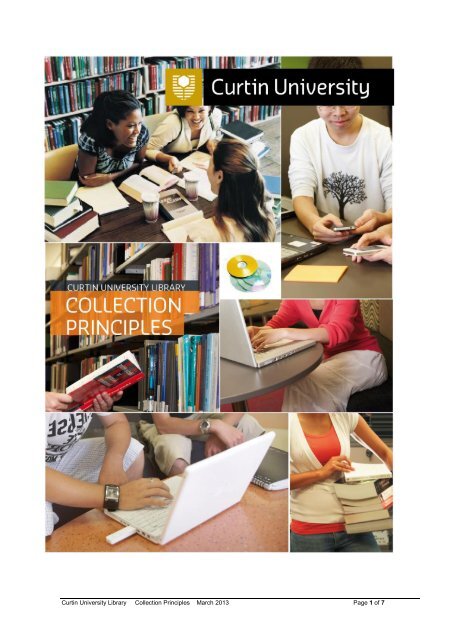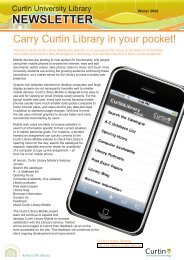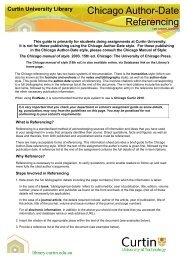Collection Principles - Curtin University Library
Collection Principles - Curtin University Library
Collection Principles - Curtin University Library
You also want an ePaper? Increase the reach of your titles
YUMPU automatically turns print PDFs into web optimized ePapers that Google loves.
<strong>Curtin</strong> <strong>University</strong> <strong>Library</strong> <strong>Collection</strong> <strong>Principles</strong> March 2013 Page 1 of 7
Introduction<br />
<strong>Curtin</strong> <strong>University</strong> is a multi-campus university with over 40,000 students and 3,500<br />
staff. 1 Courses are delivered at several campuses and education centres throughout<br />
Western Australia, and at campuses in Sydney, Malaysia and Singapore, as well as<br />
through international partner institutions. <strong>Curtin</strong> also provides an increasing number<br />
of courses through online delivery.<br />
The <strong>University</strong> <strong>Library</strong> is the primary provider of scholarly information resources for<br />
the <strong>Curtin</strong> community and has responsibility for providing the physical collection at<br />
the Robertson <strong>Library</strong>, Kalgoorlie Campus <strong>Library</strong>, <strong>Curtin</strong> Graduate School of<br />
Business <strong>Library</strong> and the John <strong>Curtin</strong> Prime Ministerial <strong>Library</strong>, as well as electronic<br />
resources to all <strong>Curtin</strong> clients regardless of location.<br />
The purpose of the <strong>Collection</strong> <strong>Principles</strong> is to provide the <strong>Curtin</strong> <strong>University</strong> community<br />
with an overview of the principles that are used in developing and maintaining the<br />
<strong>Library</strong> collection.<br />
The <strong>Library</strong>:<br />
supports teaching and learning through the provision of appropriate learning<br />
resources<br />
supports the <strong>University</strong>’s strategic directions in research and development<br />
reflects the requirements of the <strong>Library</strong> clients, based on a process of formal<br />
and informal client consultation<br />
ensures that resources are available in the most appropriate format for use by<br />
clients.<br />
The <strong>Collection</strong><br />
The <strong>Library</strong> collection has been developed since the foundation of the Western<br />
Australian Institute of Technology in 1966.<br />
In December 2012 the <strong>Collection</strong> consisted of approximately:<br />
560,000 print books<br />
330,000 ebooks<br />
30,000 audio-visual items<br />
2,700 streamed videos<br />
120,000 journal subscriptions<br />
600 scholarly electronic databases.<br />
The subject content of the <strong>Collection</strong> reflects the current and past research and<br />
teaching interests of the <strong>University</strong>.<br />
In particular, the <strong>Library</strong> collects resources to support <strong>Curtin</strong> <strong>University</strong>’s areas of<br />
research expertise:<br />
Minerals and Energy<br />
ICT and Emerging Technologies<br />
Health<br />
Sustainable Development.<br />
1 Source: <strong>Curtin</strong> <strong>University</strong> Statistics 2010: http://planning.curtin.edu.au/stats/<br />
<strong>Curtin</strong> <strong>University</strong> <strong>Library</strong> <strong>Collection</strong> <strong>Principles</strong> March 2013 Page 2 of 7
The <strong>Library</strong> holds discrete collections of primary resources relating to specific <strong>Curtin</strong><br />
projects or individual achievements at <strong>Curtin</strong> <strong>University</strong>. The <strong>Library</strong> adds value to<br />
these collections by providing access to these resources through indexing,<br />
cataloguing, digitisation and web access.<br />
The <strong>Collection</strong>’s depth varies in different subject areas, with some acknowledged and<br />
emerging strengths. In particular, the John <strong>Curtin</strong> Prime Ministerial <strong>Library</strong> is a world<br />
class collection of primary records, in various formats, that focus on the life and times<br />
of John <strong>Curtin</strong>.<br />
Access to the <strong>Collection</strong><br />
The <strong>Library</strong> makes the <strong>Collection</strong> available to the university community by providing<br />
electronic access to resources and by placing print collections on open access.<br />
Access to the <strong>Library</strong>’s electronic resources is normally restricted to current <strong>Curtin</strong><br />
students and staff. Some of these resources may also be available to <strong>Curtin</strong> Alumni<br />
and to members of the public.<br />
Anyone may access the <strong>Library</strong>’s physical collections on site. Registered <strong>Library</strong><br />
clients can borrow and/or request most items in the <strong>Collection</strong> at any <strong>Library</strong> location.<br />
The <strong>Library</strong> provides access to physical resources for eligible off-campus students<br />
and staff on request.<br />
Some items or collections are not placed on open access, owing to their fragile<br />
nature or vulnerability to theft or damage. These items can be retrieved on request.<br />
Low-use items or items duplicated in electronic format may be transferred to the<br />
<strong>Library</strong>’s offsite Store. Low use items in Store may be retrieved on request.<br />
Responsibility for Selection<br />
<strong>Library</strong> staff have primary responsibility for selecting resources to support research<br />
and teaching at <strong>Curtin</strong>.<br />
All <strong>Library</strong> clients and all <strong>Library</strong> staff are able to recommend the purchase of<br />
relevant scholarly resources.<br />
Academic staff are encouraged to be involved in the selection of library resources,<br />
and are expected to recommend those resources needed to support their research,<br />
and study units for which they are responsible.<br />
Academic staff who are recommending new teaching developments or embarking on<br />
new areas of research are also expected to meet with their Faculty Librarian to<br />
discuss the ways in which the <strong>Library</strong> can provide support.<br />
The Faculty Librarian for Business is responsible for the selection of resources to<br />
support programs run through the <strong>Curtin</strong> Graduate School of Business.<br />
The Kalgoorlie Campus Librarian, in consultation with the Faculty Librarian for<br />
Science and Engineering, selects resources that will support the teaching and<br />
research of all groups located at the Kalgoorlie campus.<br />
<strong>Curtin</strong> <strong>University</strong> <strong>Library</strong> <strong>Collection</strong> <strong>Principles</strong> March 2013 Page 3 of 7
Criteria for Selection<br />
The following criteria may be used by the <strong>Library</strong> to evaluate and prioritise<br />
recommendations:<br />
Relevance to the existing or anticipated needs of the university’s research<br />
and teaching needs<br />
Nature and extent of the existing collection within a subject area<br />
Currency<br />
Quality<br />
Price<br />
Format<br />
Language<br />
Demand<br />
Ongoing commitment and maintenance (e.g. binding)<br />
Availability of access via alternative methods (e.g. document delivery).<br />
There are particular considerations in relation to the selection of electronic resources<br />
including:<br />
Access methods including authentication issues<br />
Licensing obligations<br />
Options for perpetual access and/or archival rights<br />
Reliability<br />
Platform fees<br />
Higher cost relative to print equivalent<br />
Equity of access to all clients.<br />
<strong>Library</strong> staff regularly consult with research and teaching staff across the university to<br />
ensure that the collection develops to meet the needs of the <strong>University</strong> community.<br />
Preference for Electronic Resources<br />
In order to provide the broadest and most equitable access to the <strong>Library</strong> collection<br />
for <strong>Curtin</strong> students and staff, the <strong>Library</strong> will acquire resources in electronic format<br />
whenever possible.<br />
Budget<br />
The <strong>Library</strong>’s acquisitions budget is determined as part of the <strong>University</strong>'s annual<br />
budget process. For 2013 the <strong>University</strong> allocated $9,315,040 for the purchase of<br />
library resources.<br />
In allocating the acquisitions budget the <strong>Library</strong> gives priority to:<br />
ongoing commitments and subscriptions<br />
support for teaching and the acquisition of textbooks and recommended<br />
readings for all units taught at the <strong>University</strong><br />
resources that support the current research foci of the <strong>University</strong>.<br />
Up to eighty per cent of the <strong>Library</strong> acquisitions budget is allocated to ongoing<br />
commitments and subscriptions. The remainder is allocated to one-off purchases.<br />
<strong>Curtin</strong> <strong>University</strong> <strong>Library</strong> <strong>Collection</strong> <strong>Principles</strong> March 2013 Page 4 of 7
As a large proportion of expenditure is in foreign currency the <strong>Library</strong> works with<br />
<strong>University</strong> Financial Services to ensure that appropriate hedging mechanisms are in<br />
place to manage the risk of currency fluctuation.<br />
In terms of expenditure on information resources <strong>Curtin</strong> falls in the top 25% relative<br />
to the other Australian and New Zealand university libraries. <strong>Curtin</strong> ranked 12th of 48<br />
institutions in 2011.<br />
Subscriptions<br />
In allocating the subscriptions budget, priority is given to maintaining existing<br />
subscriptions.<br />
The <strong>Library</strong> may subscribe to:<br />
Print journals<br />
Electronic journals<br />
Indexing databases<br />
Full-text databases<br />
Ebook and videostreaming collections<br />
Individual ebooks and videostreams<br />
Electronic reference resources.<br />
Any request for a new subscription will be considered carefully because of the<br />
ongoing financial commitment, and because annual increases in subscription costs<br />
often exceed the annual inflation rate.<br />
The electronic version of a book or journal is the preferred format providing that the<br />
<strong>Library</strong> can meet the license conditions.<br />
In some circumstances it may be necessary to cancel an existing subscription. These<br />
circumstances may include:<br />
a substantial increase in subscription costs<br />
budget constraints<br />
changing needs of teaching and research staff in the <strong>University</strong><br />
changes in licensing agreements.<br />
In considering cancellations, the <strong>Library</strong> will consult with stakeholders as appropriate.<br />
Multiple Copies<br />
Wherever possible, the <strong>Library</strong> will provide electronic access for items in high<br />
demand. It should be noted, however, that textbooks are generally unavailable in<br />
electronic format for <strong>Library</strong> use.<br />
If a unit is taught at multiple locations (i.e. Bentley Campus and Kalgoorlie Campus)<br />
the textbooks and recommended readings for that unit will be available at each<br />
location.<br />
The formula the <strong>Library</strong> follows for purchasing print textbooks is that for each unit<br />
taught, the <strong>Library</strong> will provide in the first instance:<br />
one copy of a textbook for every thirty students, to a maximum of seven<br />
copies.<br />
<strong>Curtin</strong> <strong>University</strong> <strong>Library</strong> <strong>Collection</strong> <strong>Principles</strong> March 2013 Page 5 of 7
one copy of each book on the recommended reading list for every thirty<br />
students to a maximum of five copies.<br />
In addition, the <strong>Library</strong> will monitor usage, recalls and requests and if required<br />
provide additional copies of high demand items. The <strong>Library</strong> will also purchase<br />
equivalent numbers of newly-recommended editions where we hold multi copies of<br />
the previous editions of a title.<br />
Gratis Resources<br />
Donations<br />
The <strong>Library</strong> appreciates the benefits of donations in enriching our collections to<br />
support the research and teaching of the <strong>University</strong>.<br />
Donations will be accepted for inclusion in the collections on the basis of relevance to<br />
the <strong>University</strong>'s teaching and research programs and in accordance with the <strong>Library</strong>’s<br />
criteria for selection. Donations will usually be incorporated into the <strong>Library</strong>’s<br />
<strong>Collection</strong> in the appropriate location.<br />
Requests for special arrangements for donations (such as locating the donated items<br />
somewhere other than the Main <strong>Collection</strong>) will be considered and subject to<br />
approval by the <strong>University</strong> Librarian.<br />
The <strong>Library</strong> is a participating institution of the Cultural Gifts Program sponsored by<br />
the Department of Regional Australia, Local Government, Arts and Sport.<br />
The <strong>Library</strong> reserves the right to decline or dispose of donations.<br />
Internet resources<br />
<strong>Library</strong> staff may select freely available, quality Internet resources for inclusion in the<br />
<strong>Library</strong> Catalogue.<br />
Internet resources are generally accepted for inclusion in the <strong>Library</strong> Catalogue on<br />
the basis of relevance to the <strong>University</strong>'s teaching and research programs and in<br />
accordance with the <strong>Library</strong>’s criteria for selection.<br />
Unsolicited print items<br />
Unsolicited print items may include:<br />
Newsletters<br />
Free journals<br />
Annual reports<br />
Trade publications.<br />
These are generally accepted for inclusion in the collection on the basis of relevance<br />
to the <strong>University</strong>'s teaching and research programs, and in accordance with the<br />
<strong>Library</strong>’s criteria for selection.<br />
Items that are not added to the collection are discarded.<br />
Resources Not Available in the <strong>Library</strong> <strong>Collection</strong><br />
The <strong>Library</strong> aims to hold a collection adequate to support undergraduate teaching<br />
and learning; however, purchasing resources for the collection may not always be the<br />
<strong>Curtin</strong> <strong>University</strong> <strong>Library</strong> <strong>Collection</strong> <strong>Principles</strong> March 2013 Page 6 of 7
most appropriate way to support research activity. If resources cannot be purchased<br />
quickly, the <strong>Library</strong> meets the cost of supplying items through interlibrary loan and<br />
document delivery for staff and postgraduate students.<br />
In addition, the <strong>Library</strong> has reciprocal borrowing arrangements for students and staff<br />
with other Australian academic institutions.<br />
<strong>Collection</strong> Maintenance<br />
<strong>Collection</strong> Valuation<br />
In compliance with the <strong>University</strong>’s risk management requirements, regular<br />
valuations of the <strong>Library</strong> collections are conducted.<br />
Preservation<br />
The <strong>Library</strong> will maintain the physical collection in good condition, with appropriate<br />
processes for replacement, binding and repair.<br />
The <strong>Library</strong> will maintain reliable, ongoing access to electronic resources, by<br />
anticipating and planning for technological change.<br />
Replacement<br />
If a copy of an item has been lost or has been damaged beyond repair, it may be<br />
replaced either electronically or in physical format. The following factors are used by<br />
the <strong>Library</strong> to prioritise replacements:<br />
the level of use by <strong>Library</strong> clients<br />
availability of another copy to purchase<br />
availability of access via alternative methods (e.g. document delivery)<br />
the option of scanning and adding to our collection (for out of print items).<br />
Deselection and Storage<br />
<strong>Library</strong> staff are responsible for decisions on deselection and storage, and will<br />
consult with academic staff as appropriate.<br />
As a guiding principle, the <strong>Library</strong> will retain access to at least one copy, either print<br />
or electronic, of all significant resources catalogued into the collection. In certain<br />
circumstances the last copy may be deselected if the content and/or format are<br />
deemed to be inappropriate for the teaching and research needs of the university.<br />
In individual instances, decisions about the retention of print copies where there is an<br />
electronic equivalent will be based on considerations such as:<br />
frequency of use<br />
guaranteed access to an archived electronic copy which is the equivalent to<br />
print in terms of legibility, content and quality of graphic images<br />
maintenance of equity of access.<br />
Document Review<br />
The <strong>Collection</strong> <strong>Principles</strong> document is reviewed annually by the Associate Director,<br />
Research and Learning Services.<br />
<strong>Curtin</strong> <strong>University</strong> <strong>Library</strong> <strong>Collection</strong> <strong>Principles</strong> March 2013 Page 7 of 7



![Client Charter [pdf 233KB] - Curtin University Library](https://img.yumpu.com/48959406/1/184x260/client-charter-pdf-233kb-curtin-university-library.jpg?quality=85)

